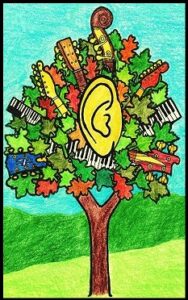Go to:  Reading Music By Ear – Part 1
Reading Music By Ear – Part 1
Musicians often say that figuring out a song by ear is like working a crossword puzzle. People who learn to play a song by ear often say they feel like they “own” the song. They often use that word – “own” – to describe the empowering feeling of opening a song like an oyster, and seeing how all the moving parts work together. To trained listeners, music is a hologram.
Welcome to my world.
The ability to interpret what you hear directly in terms of your instrument gives you a sense of freedom that most musicians will never experience. Many formally-trained musicians can’t approach a piece of music unless someone has prepared a written arrangement to tell them how to play it. Playing by ear frees you from that limitation.
For working rock musicians like me, there is no alternative to reading music by ear. Sheet music with detailed guitar, bass or keyboard parts is simply not available for most recorded rock and country songs. Reading by ear allows me to quickly and accurately write charts or staff for songs I’ve never heard before. It also allows me to find mistakes in printed music for recorded songs. (Yes, mistakes do occur in printed music.)
It’s even possible to reverse-engineer some classical music by ear. I reverse-engineered Christopher Parkening’s
recording of Bach’s Prelude 1, and also a live version of Mood For A Day that had no sheet music. Rock, country and jazz musicians have to be able to read music by ear. They have to be able to memorize and retain the music they figure out by ear. Rock and country musicians are as dependent on reading music by ear as classical musicians are on reading written music.
Most in the “classical school” don’t regard this reverse-engineering process as “reading.” That’s consistent with their definition of “musical literacy.” However, “reading” is obtaining information by any means. Reading isn’t always visual. For instance, reading braille isn’t visual. Magnetic hard drives, flash drives and seismometers all read data non-visually.
Reading by ear has its limitations. You’re limited by the quality of the recording you’re trying to read. There are limits to the complexity of the music you can decode by ear. Complicated piano parts can be almost completely opaque, unless you have a good ear for close harmonies, and you understand advanced piano techniques. Otherwise, if the sound separation in the recording is good, a trained musician can accurately dissect even complex arrangements with multiple instruments.
In the world of rock music, reading by ear is taken for granted. Most rock players are good at reading by ear. It’s how much of the official published sheet music for pop, rock and country songs is written. More about that later. There are even a small percentage of competent play-by-ear musicians who don’t know anything about note names or number systems. If you listen to music, you probably have some amount of ear-training that you’re not even aware of.
Reading music by ear is a different mental process from sight-reading music, and the two have different applications. The great thing about reading sheet music is that a group of musicians who don’t know any of the same music can perform together without any prior rehearsal. This is important in many professional settings, but it is irrelevant in many other situations.
It all goes to show the importance of learning to play music by ear.